<p align="center">
<a href="https://fastdash.app/"><img src="https://storage.googleapis.com/fast_dash/0.1.8/logo.png" alt="Fast Dash" width=300></a>
</p>
<p align="center">
<em>Open source, Python-based tool to build prototypes lightning fast ⚡</em>
</p>
<p align="center">
<a href="https://pypi.python.org/pypi/fast_dash">
<img src="https://img.shields.io/pypi/v/fast_dash?color=%2334D058&labelColor=black"
alt = "Release Status">
</a>
<a href="https://github.com/dkedar7/fast_dash/actions">
<img src="https://github.com/dkedar7/fast_dash/actions/workflows/release.yml/badge.svg?labelColor=black" alt="CI Status">
</a>
<a href="https://github.com/dkedar7/fast_dash/blob/main/LICENSE">
<img src="https://img.shields.io/github/license/dkedar7/fast_dash?color=2334D058&labelColor=black" alt="MIT License">
</a>
<a href="https://docs.fastdash.app/">
<img src="https://img.shields.io/badge/Docs-MkDocs-<COLOR>.svg?labelColor=black&color=%2334D058" alt="Documentation">
</a>
<a href="https://pepy.tech/project/fast-dash">
<img src="https://static.pepy.tech/personalized-badge/fast-dash?period=total&units=international_system&left_color=black&right_color=brightgreen&left_text=Downloads" alt="Downloads">
</a>
<a href="https://codecov.io/gh/dkedar7/fast_dash" >
<img src="https://codecov.io/gh/dkedar7/fast_dash/graph/badge.svg?token=9QJvbeQ1g8"/>
</a>
</p>
---
* **Documentation**: [https://docs.fastdash.app](https://docs.fastdash.app)
* **Source code**: [github.com/dkedar7/fast_dash](https://github.com/dkedar7/fast_dash/)
* **Installation**: `pip install fast-dash`
---
Fast Dash is a Python module that makes the development of web applications fast and easy. It can build web interfaces for Machine Learning models or to showcase any proof of concept without the hassle of developing UI from scratch.
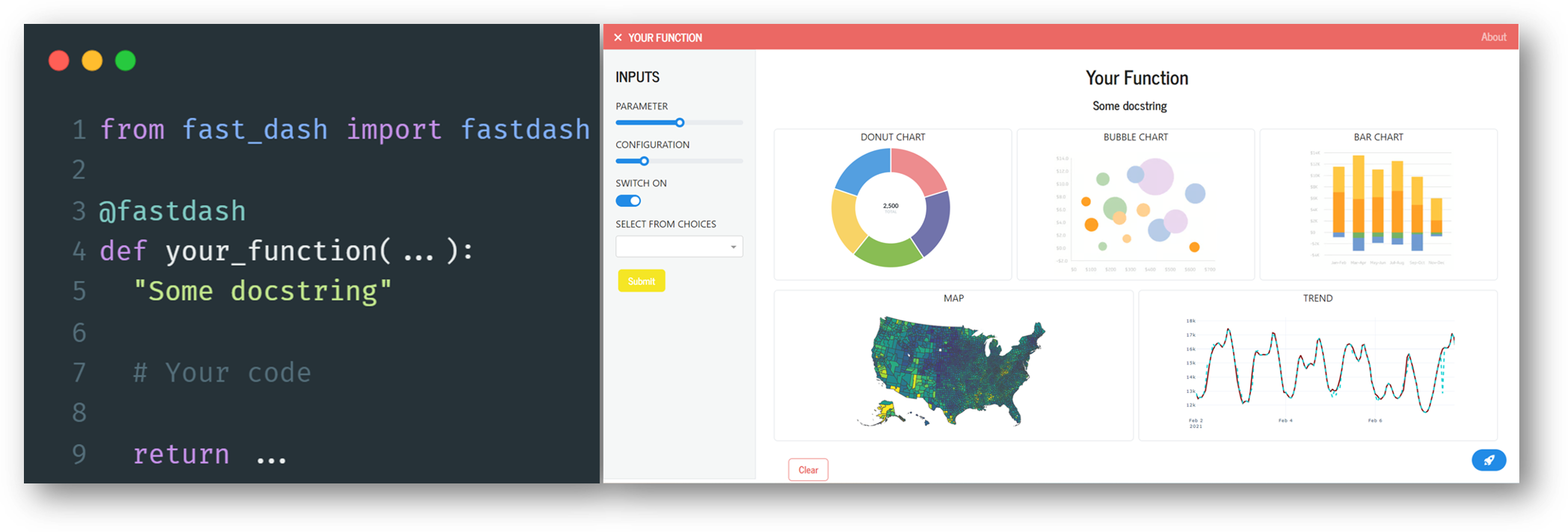
## Examples
With Fast Dash's decorator `@fastdash`, it's a breeze to deploy any Python function as a web app. Here's how to use it to write your first Fast Dash app:
```python
from fast_dash import fastdash
@fastdash
def text_to_text_function(input_text):
return input_text
# * Running on http://127.0.0.1:8080/ (Press CTRL+C to quit)
```
And just like that, we have a completely functional interactive app!
Output:
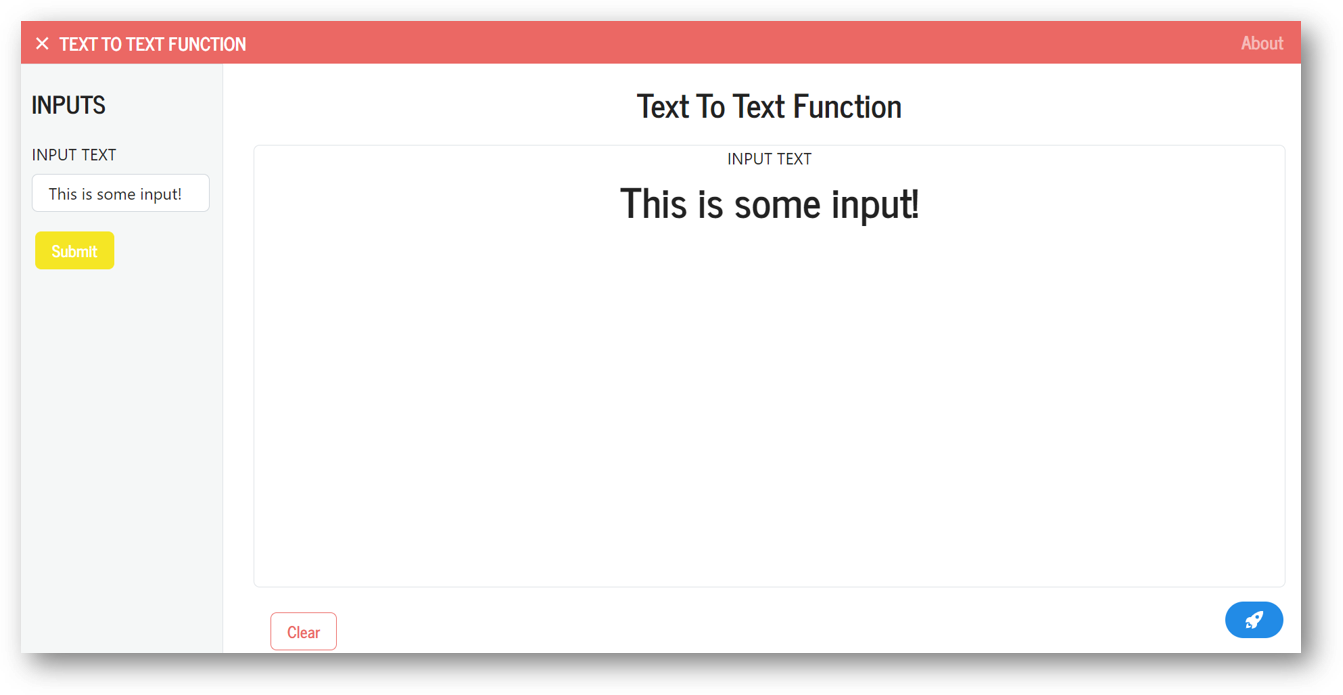
---
Fast Dash can read all the function details, like its name, input and output types, docstring, and uses this information to infer which components to use.
For example, here's how to deploy an app that takes a string and an integer as inputs and returns some text.
```python
from fast_dash import fastdash
@fastdash
def display_selected_text_and_number(text: str, number: int) -> str:
"Simply display the selected text and number"
processed_text = f'Selected text is {text} and the number is {number}.'
return processed_text
# * Running on http://127.0.0.1:8080/ (Press CTRL+C to quit)
```
Output:
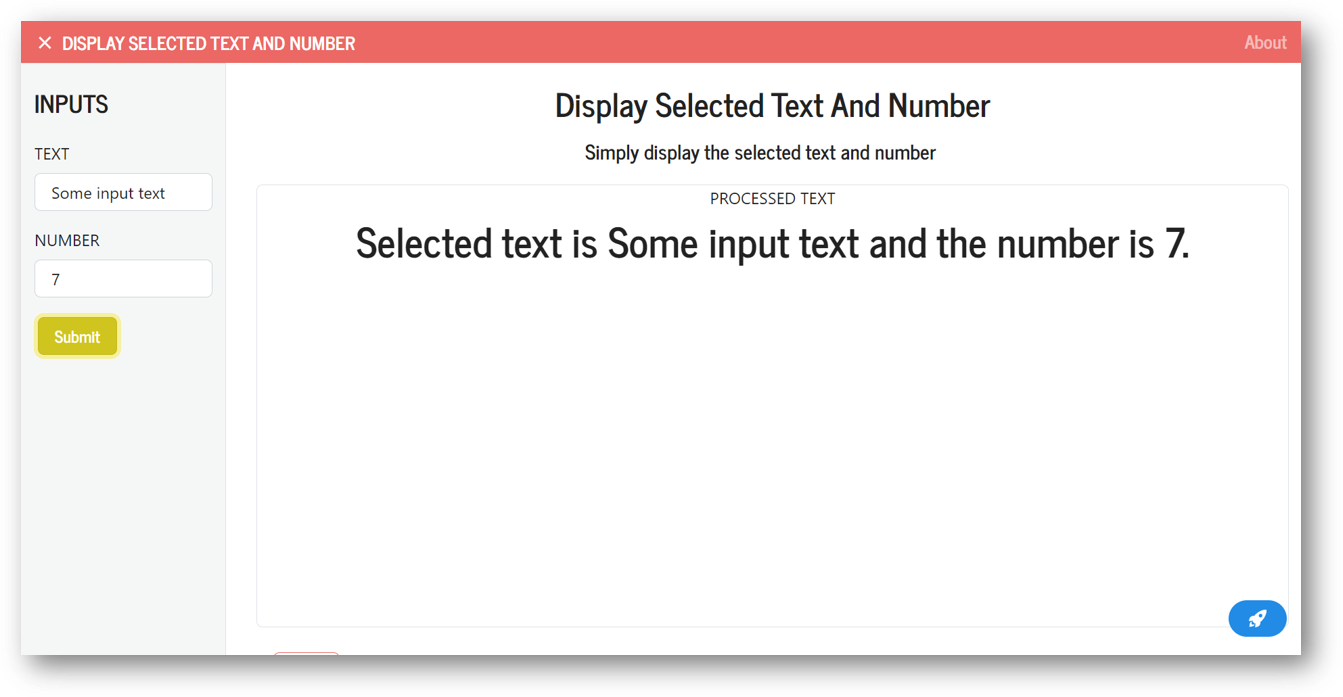
And with just a few more lines, we can add a title icon, subheader and other social branding details.
---
Output components can be arranged using a mosaic layout (ASCII art), inspired from Matplotlib's `subplot_mosaic` feature.
```python
from fast_dash import fastdash, UploadImage, Graph
import matplotlib.pyplot as plt
mosaic = """
AB
AC
"""
@fastdash(mosaic=mosaic, theme="BOOTSTRAP")
def multiple_output_components(start_date: datetime.date, # Adds a date component
upload_image: UploadImage, # Adds an upload component
fips: str = [List of FIPs]) # Adds a single select dropdown
-> (Graph, plt.Figure, plt.Figure):
# Output components are a Plotly graph, and two figure components
"Fast Dash allows using mosaic arrays to arrange output components"
choropleth_map = ...
histogram = ...
radar_chart = ...
return chloropleth_map, histogram, radar_chart
# * Running on http://127.0.0.1:8080/ (Press CTRL+C to quit)
```
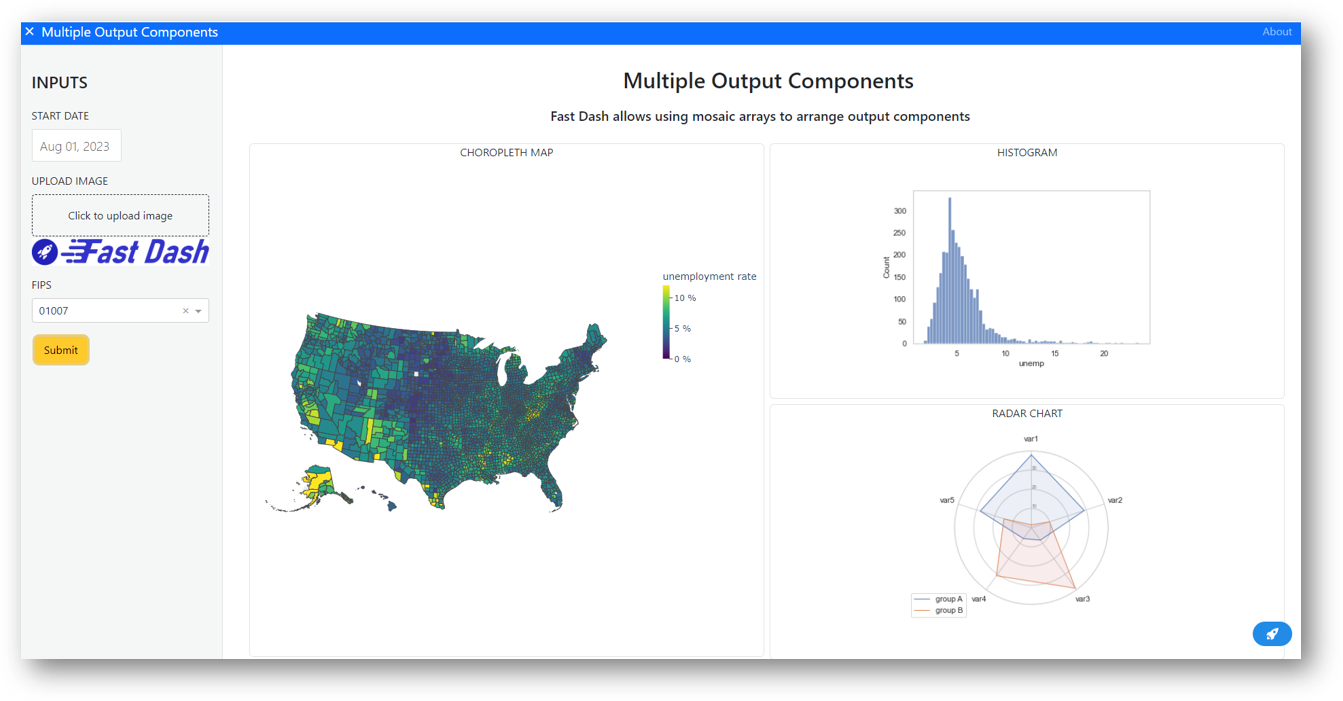
In just a few lines of code, you can also add a chat component.
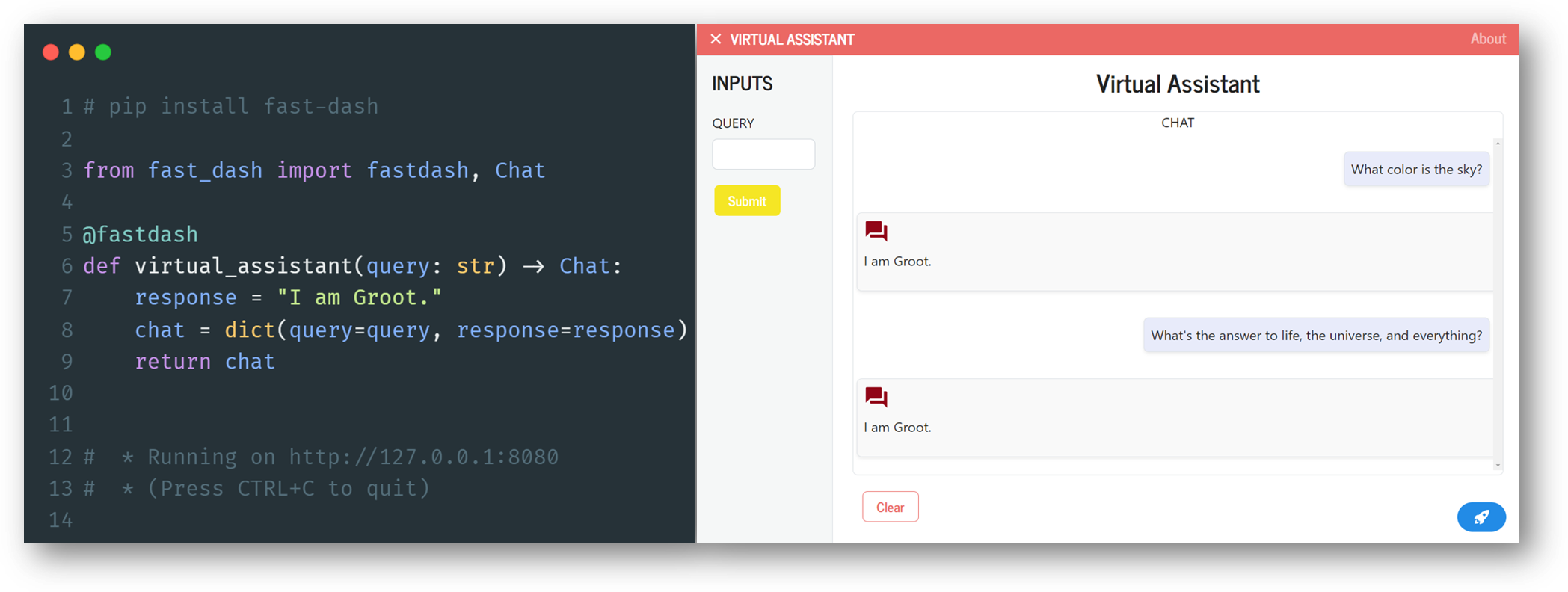
You can use your favorite Python libraries. Here's an example of an advanced geospatial application built using `geemap` and Google Earth Engine.
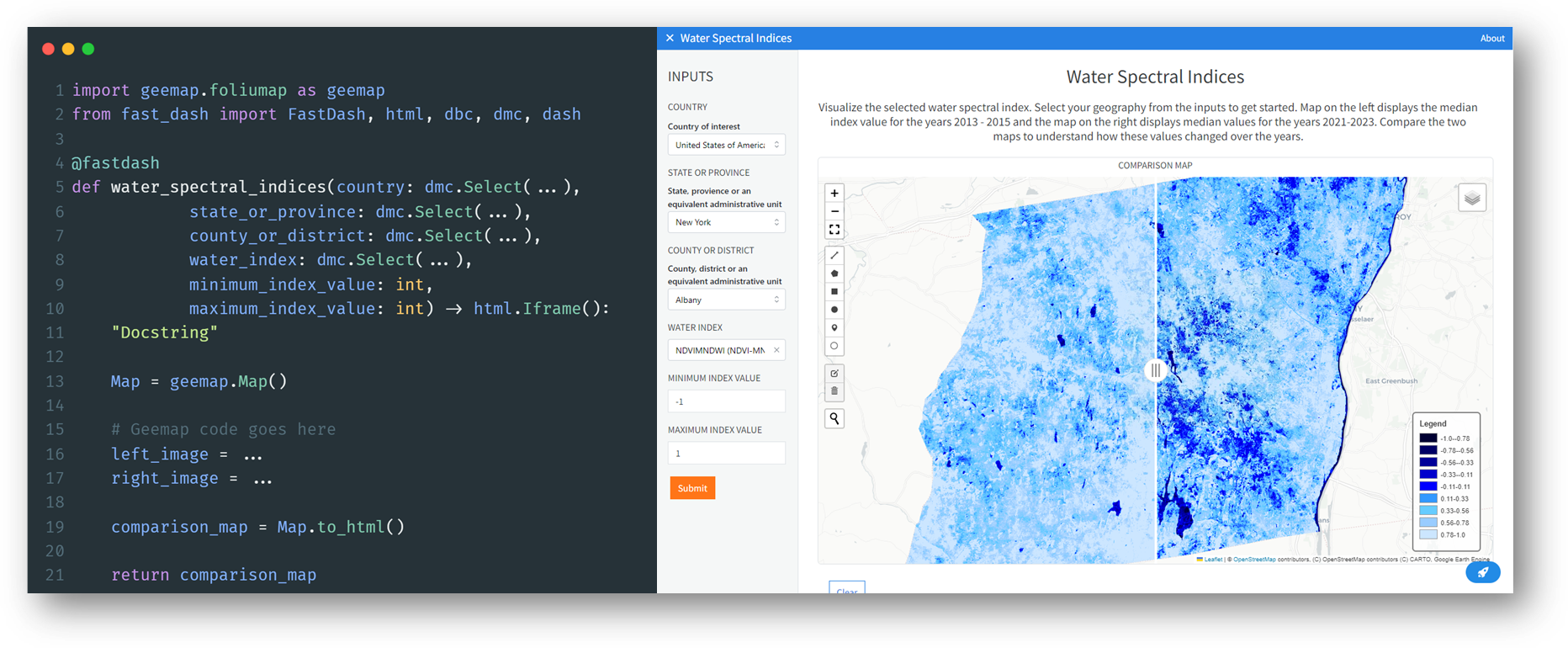
## About
Read different ways to build Fast Dash apps and additional details by navigating to the [project documentation](https://docs.fastdash.app/).
### Key features
Duild and deploy a web app by adding a decorator only.
- Components are inferred from function type hints. Allows using Dash components as type hints.
- Use multiple input and output components simultaneously.
- Build fast, share and iterate.
## Community
Fast Dash is built using [Plotly Dash](https://github.com/plotly/dash) and it's completely open-source.
Raw data
{
"_id": null,
"home_page": null,
"name": "fast-dash",
"maintainer": null,
"docs_url": null,
"requires_python": "<3.14,>=3.9",
"maintainer_email": null,
"keywords": "webdevelopment, python, machine-learning, data-science, data-visualization, dash",
"author": "Kedar Dabhadkar",
"author_email": "<kedar@fastdash.app>",
"download_url": "https://files.pythonhosted.org/packages/6d/29/06dc519b44062850312bb9818878f5918b18a9e3181ff6b98665b5adb6b7/fast_dash-0.2.10.tar.gz",
"platform": null,
"description": "<p align=\"center\">\n <a href=\"https://fastdash.app/\"><img src=\"https://storage.googleapis.com/fast_dash/0.1.8/logo.png\" alt=\"Fast Dash\" width=300></a>\n</p>\n<p align=\"center\">\n <em>Open source, Python-based tool to build prototypes lightning fast \u26a1</em>\n</p>\n<p align=\"center\">\n<a href=\"https://pypi.python.org/pypi/fast_dash\">\n <img src=\"https://img.shields.io/pypi/v/fast_dash?color=%2334D058&labelColor=black\"\n alt = \"Release Status\">\n</a>\n<a href=\"https://github.com/dkedar7/fast_dash/actions\">\n <img src=\"https://github.com/dkedar7/fast_dash/actions/workflows/release.yml/badge.svg?labelColor=black\" alt=\"CI Status\">\n</a>\n<a href=\"https://github.com/dkedar7/fast_dash/blob/main/LICENSE\">\n <img src=\"https://img.shields.io/github/license/dkedar7/fast_dash?color=2334D058&labelColor=black\" alt=\"MIT License\">\n</a>\n<a href=\"https://docs.fastdash.app/\">\n <img src=\"https://img.shields.io/badge/Docs-MkDocs-<COLOR>.svg?labelColor=black&color=%2334D058\" alt=\"Documentation\">\n</a>\n<a href=\"https://pepy.tech/project/fast-dash\">\n <img src=\"https://static.pepy.tech/personalized-badge/fast-dash?period=total&units=international_system&left_color=black&right_color=brightgreen&left_text=Downloads\" alt=\"Downloads\">\n</a>\n\n<a href=\"https://codecov.io/gh/dkedar7/fast_dash\" > \n <img src=\"https://codecov.io/gh/dkedar7/fast_dash/graph/badge.svg?token=9QJvbeQ1g8\"/> \n </a>\n\n\n</p>\n\n\n---\n\n* **Documentation**: [https://docs.fastdash.app](https://docs.fastdash.app)\n* **Source code**: [github.com/dkedar7/fast_dash](https://github.com/dkedar7/fast_dash/)\n* **Installation**: `pip install fast-dash`\n\n---\n\nFast Dash is a Python module that makes the development of web applications fast and easy. It can build web interfaces for Machine Learning models or to showcase any proof of concept without the hassle of developing UI from scratch.\n\n\n\n## Examples\n\nWith Fast Dash's decorator `@fastdash`, it's a breeze to deploy any Python function as a web app. Here's how to use it to write your first Fast Dash app:\n```python\nfrom fast_dash import fastdash\n\n@fastdash\ndef text_to_text_function(input_text):\n return input_text\n\n# * Running on http://127.0.0.1:8080/ (Press CTRL+C to quit)\n```\n\nAnd just like that, we have a completely functional interactive app!\n\nOutput:\n\n---\n\nFast Dash can read all the function details, like its name, input and output types, docstring, and uses this information to infer which components to use.\n\nFor example, here's how to deploy an app that takes a string and an integer as inputs and returns some text.\n\n```python\nfrom fast_dash import fastdash\n\n@fastdash\ndef display_selected_text_and_number(text: str, number: int) -> str:\n \"Simply display the selected text and number\"\n\n processed_text = f'Selected text is {text} and the number is {number}.'\n \n return processed_text\n\n# * Running on http://127.0.0.1:8080/ (Press CTRL+C to quit)\n```\n\nOutput:\n\n\nAnd with just a few more lines, we can add a title icon, subheader and other social branding details.\n\n---\n\nOutput components can be arranged using a mosaic layout (ASCII art), inspired from Matplotlib's `subplot_mosaic` feature.\n\n```python\nfrom fast_dash import fastdash, UploadImage, Graph\nimport matplotlib.pyplot as plt\n\nmosaic = \"\"\"\nAB\nAC\n\"\"\"\n\n@fastdash(mosaic=mosaic, theme=\"BOOTSTRAP\")\ndef multiple_output_components(start_date: datetime.date, # Adds a date component\n upload_image: UploadImage, # Adds an upload component\n fips: str = [List of FIPs]) # Adds a single select dropdown\n -> (Graph, plt.Figure, plt.Figure): \n # Output components are a Plotly graph, and two figure components\n\n \"Fast Dash allows using mosaic arrays to arrange output components\"\n\n choropleth_map = ...\n histogram = ...\n radar_chart = ...\n \n return chloropleth_map, histogram, radar_chart\n\n# * Running on http://127.0.0.1:8080/ (Press CTRL+C to quit)\n```\n\n\nIn just a few lines of code, you can also add a chat component.\n\n\n\nYou can use your favorite Python libraries. Here's an example of an advanced geospatial application built using `geemap` and Google Earth Engine.\n\n\n\n## About\n\nRead different ways to build Fast Dash apps and additional details by navigating to the [project documentation](https://docs.fastdash.app/).\n\n### Key features\n\n Duild and deploy a web app by adding a decorator only.\n- Components are inferred from function type hints. Allows using Dash components as type hints.\n- Use multiple input and output components simultaneously.\n- Build fast, share and iterate.\n\n## Community\n\nFast Dash is built using [Plotly Dash](https://github.com/plotly/dash) and it's completely open-source.\n",
"bugtrack_url": null,
"license": "MIT",
"summary": "Turn your Python functions into interactive web applications. Fast Dash is an innovative way to build and deploy your Python code as interactive apps with minimal changes to your original code.",
"version": "0.2.10",
"project_urls": null,
"split_keywords": [
"webdevelopment",
" python",
" machine-learning",
" data-science",
" data-visualization",
" dash"
],
"urls": [
{
"comment_text": null,
"digests": {
"blake2b_256": "943c241c3beffcf8db9a4907fcdfb6136b3c9948b236e03859ce3c38284ba228",
"md5": "6e9db8b7aef9be9e9edf61651f4d8c14",
"sha256": "b2263e822134306d8ae85aac64982c2a8e7e59aafddf4d8fecd3e2820d9f3740"
},
"downloads": -1,
"filename": "fast_dash-0.2.10-py3-none-any.whl",
"has_sig": false,
"md5_digest": "6e9db8b7aef9be9e9edf61651f4d8c14",
"packagetype": "bdist_wheel",
"python_version": "py3",
"requires_python": "<3.14,>=3.9",
"size": 46960,
"upload_time": "2025-02-17T04:52:45",
"upload_time_iso_8601": "2025-02-17T04:52:45.513497Z",
"url": "https://files.pythonhosted.org/packages/94/3c/241c3beffcf8db9a4907fcdfb6136b3c9948b236e03859ce3c38284ba228/fast_dash-0.2.10-py3-none-any.whl",
"yanked": false,
"yanked_reason": null
},
{
"comment_text": null,
"digests": {
"blake2b_256": "6d2906dc519b44062850312bb9818878f5918b18a9e3181ff6b98665b5adb6b7",
"md5": "68712b56272f40f8176fd5b0b6ceb288",
"sha256": "51ade74810ecf8c935e8f01bcaafdcb6868a65b68451f0ad59b5897fef2ff9ba"
},
"downloads": -1,
"filename": "fast_dash-0.2.10.tar.gz",
"has_sig": false,
"md5_digest": "68712b56272f40f8176fd5b0b6ceb288",
"packagetype": "sdist",
"python_version": "source",
"requires_python": "<3.14,>=3.9",
"size": 49340,
"upload_time": "2025-02-17T04:52:47",
"upload_time_iso_8601": "2025-02-17T04:52:47.440406Z",
"url": "https://files.pythonhosted.org/packages/6d/29/06dc519b44062850312bb9818878f5918b18a9e3181ff6b98665b5adb6b7/fast_dash-0.2.10.tar.gz",
"yanked": false,
"yanked_reason": null
}
],
"upload_time": "2025-02-17 04:52:47",
"github": false,
"gitlab": false,
"bitbucket": false,
"codeberg": false,
"lcname": "fast-dash"
}